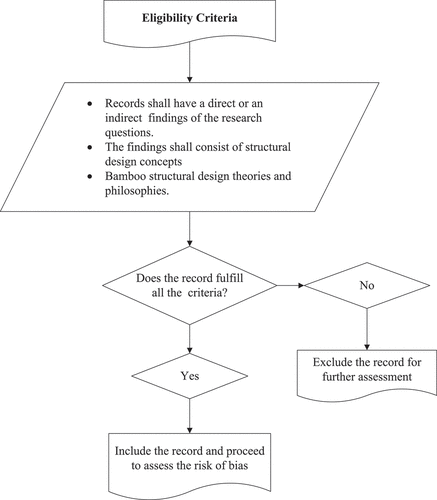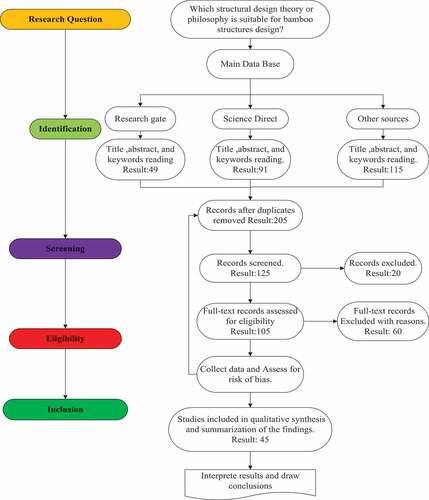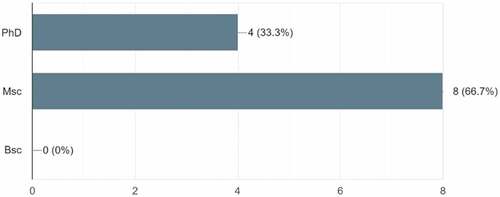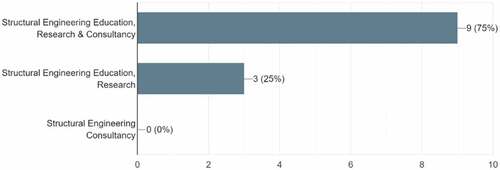 ?Mathematical formulae have been encoded as MathML and are displayed in this HTML version using MathJax in order to improve their display. Uncheck the box to turn MathJax off. This feature requires Javascript. Click on a formula to zoom.
?Mathematical formulae have been encoded as MathML and are displayed in this HTML version using MathJax in order to improve their display. Uncheck the box to turn MathJax off. This feature requires Javascript. Click on a formula to zoom.Abstract
This article reviews the existing design philosophies of structural elements made of different structural materials in general and bamboo materials in specific. The theories behind design practice would be the main cornerstone for articulating why and how we employ a single philosophy. The demand for using verified theories or philosophies will facilitate the drawing of sound models. The detailed theoretical basis and methods that include the fundamental one are studied through extensive literature reviews in an organized way, and a critical synthesis has been made upon the basic parameters identified. Establishing a sound philosophy to address the existing behavior of materials and loads takes quite a time. Philosophies like allowable stress design, load factor design, and limit state design are the classical ones, while capacity-based, performance-based, and risk-based are the emerging ones for structural element design. The key characteristics for addressing the possible factors for developing a philosophy, whether classical or emerging, are valuable to seek out. The paper identifies the key parameters to develop a design philosophy using a Delphi survey from selected scientists. The key parameters found are material behavior, load behavior, displacement, failure modes, functionality, and method of construction. The identified key parameters need to be incorporated while developing a sound structural design philosophy. It is found that there is a significant relationship between material properties and design philosophy available when the force-based design approach is preferred, but if the functional-based and displacement-based approaches are used, there is no significant relationship between material properties and design philosophy.
PUBLIC INTEREST STATEMENT
Finding the best sections and elements for a structure involves using several materials, each of which exhibits a unique mechanical behavior when subjected to external stresses. Inherent philosophical issues govern the method used to calculate the stress on structures and identify the best materials and sections. Because design is iterative, it requires strong theoretical underpinnings when applying the method to the creation of structures like bamboo. Different design ideas can be used to create structures out of raw or processed bamboo. The determination of important parameters that assist in developing and supporting the design method’s theoretical justification depends on the chosen philosophical stance. The outlined key elements are needed to establish solid structural design philosophies based on bamboo’s structural responses to a variety of loads.
1. Introduction
The demand for satisfactory structural design is an unavoidable “mechanical resistance and stability” requirement (Sedlacek & Stangenberg, Citation2000). These characteristics are key elements in the design of structures. Engineering materials are frequently invented for the first time and used as a new material, with a high factor of safety, before being adjusted over time based on testing and experience (Gatóo et al., Citation2014).
Structural design involves determining the proportions of load-bearing members and modeling the load-bearing structure to meet material strength, efficiency, and durability demands over the structure’s service life (Borgström & Karlsson, Citation2016). The key concerns in the structural design of buildings are material behavior and building efficiency. The materials’ behavior is determined by testing criteria as well as the design philosophy (Correal, Citation2020). The Limit States or Load and Resistance Factor Design is the current design format for structural timber in North America, Europe, Australia, and many other parts of the world. These standards are based on a philosophy that determines the “limits” of acceptable structural behavior in terms of function and appearance, strength or damage, robustness and public safety, and tolerance to multiple combinations of anticipated effects. Building codes have performance criteria in the form of minimum standards designed to protect life, health, property, and public safety by regulating design, construction, material quality, use and use, location, and operation (Correal, Citation2020; Crews et al., Citation2016).
The structural design practice of bamboo structures is in its infant stages for some nations since there are many untapped discussions and discourses about the characterization of the different species of bamboo found in different locations. There are over 1500 different varieties of bamboo, each with a different size and characteristics—the key difference in bamboo species is between running types and clumping types (Silva et al., Citation2019). Engineered structural bamboo products (SBPs), which are similar to engineered wood products such as plywood and glue-laminated timber, have recently gained popularity (Dixon & Gibson, Citation2014). Bamboo is an abundant resource, flexible, solid, sustainable, and eco-friendly fiber. It is the fastest-growing woody plant in the grass family, subfamily Bambusoideae, providing a mature fiber for use in three years (Huang, Citation2021).
Along with its many advantages to humanity, bamboo has outstanding additional functional qualities. It significantly reduces CO2 emissions, and it contributes significantly more to carbon sequestration than other plants (Xu et al., Citation2022). For structural uses, the light weight would be advantageous due to its practical seismic resistance and excellent strength-to-weight ratio (Sharma et al., Citation2015; Zhihua et al., Citation2022). The materials would be favored for the triangulated spatial structures due to their higher axial load carrying capacity (E. Amede et al., Citation2022; Hailemariam et al., Citation2022; Perfetto et al., Citation2020).
Although bamboo has been used for millennia for structural purposes throughout the world, research on its structural qualities is relatively new and scarce. However, engineers identified the need to research the mechanical properties of bamboo from the late 19th century (Trujillo & López, Citation2020) and it is noted that bamboo has evolved to be a highly efficient composite material or “smart structures”. Bamboo is a versatile construction material due to its desirable mechanical properties, high flexibility, rapid growth rate, lightweight, and low purchasing cost (Van der Lugt et al., Citation2006). To create characteristic values of both the strengths and the Young’s moduli of each bamboo species for limit state structural design, a systemic test series with a large number of compression and bending tests can be carried out (Chung & Yu, Citation2002; Sharma et al., Citation2015).
Models, standards, and codes would be a means to derive characteristic design values and allowable stress for the design of the bamboo structures. Calculations must be used to ensure that no relevant limit state or allowed stress is exceeded in bamboo structure design concepts (E. A. Amede et al., Citation2021; Harries et al., Citation2020; Janssen, Citation2005; Kaminski et al., Citation2016). Design with bamboo has been difficult for architects and engineers due to its irregular shape and round section (Wang et al., Citation2017; Witte, Citation2019). The assessment of structural material strength is a basic feature of every design code. As opposed to industrially man-made materials such as steel or aluminum, natural materials such as timber and bamboo have a great deal of variability (Trujillo et al., Citation2017; Trujillo, Citation2013, August; August).
A simplified way of designing nonconventional materials employs an allowable stress method, in which a member’s capacity is limited by its characteristic material strength divided by a “factor of safety”. The majority of traditional engineering material design codes were based on variations of an acceptable stress method. Allowable strength techniques require more technical work and an understanding of the intended final structural application. For highly variable materials utilized in their natural state, such as bamboo, an acceptable member strength approach may be more suited. This approach, however, leads to more complicated test standard requirements (Harries et al., Citation2020; Harries & Sharma, Citation2019).
By the late 1970s, the movement toward limit states design was well known, and the benefits of providing a standard set of load conditions that could be applicable to all building materials became apparent (Ellingwood, Citation1994). There is a shift in the philosophy of structural design from traditional force-based design (FBD) to displacement-based design (DBD). In DBD design philosophy, lateral displacement of nonstructural components governs the whole design criterion. DBD is getting popular starting year 2000 and it is getting momentum, especially in earthquake-prone areas like Japan, New Zealand, Italy, and California. In current traditional force-based design, the type of material is taken into account in the strength factor and ductility, while, as in the philosophy of DBD design, the type of material is not taken into account in the design process (Muljati & Hartono, Citation2017).
A large number of design parameters affect the performance of the structural system based on seismic design considerations. Material cost is an important aspect of building construction. Minimizing the weight of structural elements unfolds economical structures, but at the same time, structural stability and soundness are required to be ensured under extreme loading conditions, especially earthquakes. In Force-Based Design (FBD), assumptions were made about the member sizes and their stiffness before the design seismic forces are determined. Consequently, if the member sizes are modified from the initial assumption, then the calculated design force will no longer be valid, and recalculation, though rarely carried out is theoretically required (Ghazi & Shabbir, Citation2018) .
There is a range of design recommendations on structural timber, such as (BS5268, Citation2007) and (American Forest and Paper Association, Citation2001), and most of them have traditionally used allowable stress design. The ultimate limit state design philosophy is used in contemporary structural timber codes such as (Canadian Standards Association, Citation2009) and (Eurocode 5, Citation2004), and structural adequacy is measured for characteristic values of both loading and resistance using sufficient partial safety factors.
On the other hand, durability design is still commonly used and is based on old experience codes of good practice. It is, though, a risky approach that has resulted in many reliability issues. A design based on a service life estimation has many benefits, but it is somewhat complicated. A large amount of information about functional parameters, climate, degradation process, and material is required (Fagerlund, Citation1985). In this paper, a literature review of structural design philosophies is forwarded by establishing a clear review protocol, and the key parameters for developing the philosophies are also identified using an expert opinion through the Delphi survey.
2. Research methodology
2.1. Literature review process
The primary research approach of the study is a literature review, which aims to collect and critically assess several research studies. The following question was attempted to be answered in the research paper: Which theory or philosophy of structural design is appropriate for the design of structural elements of bamboo?
The reviewing protocol, as indicated in Table , is used in this paper. The given protocol demonstrates the key literature collections as well as a criterion of eligibility from the specified databases. Since the research of bamboo as a structural material is emerging, the accumulated records are determined regularly up to the year 2022.
Table 1. Literature review protocol of bamboo structural design philosophy
The paper aims to answer the philosophical issues that should be employed in the design of bamboo structures. The design process of bamboo structures and the theoretical basis followed are analyzed and synthesized. A configurative and content-based search strategy was also employed to collect the significant literature towards the objective of the paper.
The databases are science direct, research gate and other sources from these a total of 205 works of literature have been collected after duplication of records are removed. By setting screening and eligibility criteria for inclusion and exclusion of the literature, 125 literatures are included, and the full texts used for synthesis and summarization of findings after checking the risk of bias for each literature are 45. The bias is based on the content of the literature that shares partiality in addressing different philosophies of structural design. The flow chart (Figure )shows a clear set of criteria and how it has been decided to select text records for further action.
The eligibility criteria have been formulated based on the research question. Records shall have a direct or an indirect finding of the research questions, the findings shall consist of structural design concepts and theories, and bamboo structural design theories and philosophies.
To prevent conceptual misunderstandings, the assessment of bias risk was created. Systematic flaws or limitations in the review’s planning or execution could bias its results. Users must consider these possible biases when interpreting the findings and recommendations of a review because bias can occur at any level of the review process (Van der Werf & Gilliland, Citation2017; Whiting et al., Citation2016).
The following chart (Figure ) illustrates the flowchart of the literature review process followed in this paper. Interpretation of the findings and conclusions drawn have been made following qualitative synthesis.
2.2. Delphi survey
The research paper also attempted to answer the following question to determine the essential characteristics of developing design philosophies: What are the critical parameters for developing structural design philosophies or theories? By identifying essential parameters, the study attempted to develop the foundation of a code of practice and standard formulation or preparation.
The methods used are an overview of the state-of-the-art design philosophies and the Delphi survey. The survey has three rounds of questions and these questions are sent to scientists and engineers where they are purposely selected based on the following criteria, and the number of respondents for the study for each round was approximately 10 (ten) to 15 (fifteen). The criteria are (i) participation and willingness to respond to the 3 (three) rounds of questions through the internet-based questionnaire (Google form). (ii) experience in structural design, teaching, or research work on the areas of structural design theory and philosophy. (iii) extensive exposure to the analysis and design of structural elements. The selection of these experts is not bound to specific regions or countries and cultures. The questions of the Delphi survey on the objective of the study are formulated as follows (Table ).
Table 2. Delphi survey questions organization
The respondents have had plenty of time to respond to each round of questions. In each round, all of the questions were answered by all of the respondents. Before the second set of surveys, the first round of data gathering was finished. Using a five-point Likert scale (Vagias, Citation2006), the second-round survey assesses the level of relevance of the important factors identified in round 1. The third-round survey is a final remark for the scientist to respond to on the previously offered viewpoint, as well as to assist the respondent in summarizing the results.
3. Findings and discussions
3.1. Literature review discussions
The function of structural design should ideally be straightforward. It is the transformation of the outcomes of several environmental and man-made acts (such as material, dimension, and cost limitations, among others) into acceptable material specifications, structural member sizes, and arrangements (Figure ).
Figure 3. The conceptual role of structural design (Anwar & Najam, Citation2017).

The design process is also depicted by (Anwar & Najam, Citation2017) as follows (Figure ). It begins with a conceptual design and planning stage, which includes the creation of functional and structural system plans. The second stage consists of modeling and analysis of structural members proposed based on a trial or expert judgment of the size of the members. The third stage is design and details, which includes member design and back-and-forth analysis until the required member is discovered. This stage also includes the execution of the output section and member details. The last stage would involve the creation of output documents, estimates, and methodologies.
Figure 4. Overall structural design process (Anwar & Najam, Citation2017).
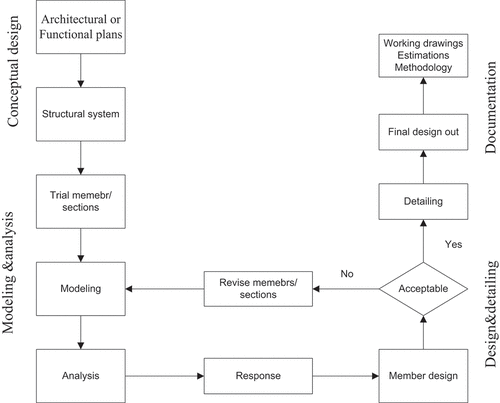
The primary goal of all structural design is to ensure that the structure will perform satisfactorily during its intended life (Arya, Citation2009). The structure should be able to withstand all predicted loads while exhibiting acceptable deformation. The basic concept of structural design was limited to ensuring that the design loads on the structures did not exceed the design strength of the materials. But what if the structure becomes unsuitable for its original use during its useful life? It will raise the question of which philosophical basis we are using for the desired material, is it working stress? Is it resistant to load factor? Is it a limit state? And understanding why we adopt a philosophy for material is useful in the development of design philosophies. The limit state philosophy can be illustrated using frequency distribution curves for design strengths and design load effects, as shown in Figure .
Figure 5. Relationship between design strengths and design load effects (Arya, Citation2009).
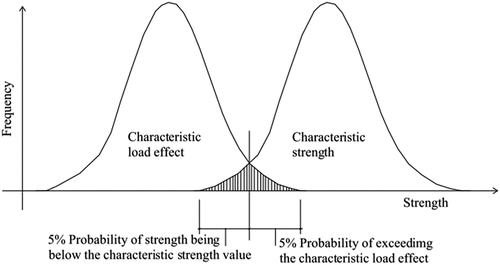
The shaded region represents the likelihood of failure, which is defined as the level of impact of the design load likely to be exceeded by 5% of the samples and the level of design strength predicted to be less than 5% of the samples. When the design strength reaches the design load effects at the junction of these two distribution curves, the ultimate limit condition occurs.
In the latter half of the nineteenth century, the introduction of new materials and the advancement of statistical simulation techniques contributed to the introduction of a design philosophy that involved the concept of factor of safety based on established material strength, such as ultimate tensile stress; this is known as allowable stress design. Two new design philosophies evolved over the twentieth century: load-factor design and limit-state design (Arya, Citation2009).
The stress in the structure during working loads is not allowed to exceed a particular proportion of the yield stress of the building material, i.e., the stress levels are limited to the elastic range in allowable stress design, also known as a modular ratio or elastic design. The actual stress in the material can be calculated by assuming that the stress-strain relationship over this range is linear. Despite the fact that it simulated real-world building performance, this concept had two fundamental shortcomings. To begin with, permitted design methodologies sometimes overcomplicated the design process and resulted in cautious solutions. Second, as material quality improved and safety margins shrank, the assumption that stress and strain are directly proportional became unjustifiable for materials such as concrete, making it impossible to evaluate genuine safety factors.
The load factor, also known as plastic design, was created to account for the behavior of the structure once the yield point of the construction material was reached. This method involved determining the collapse load of the structure. By dividing the collapse load by a load factor, the working load was calculated. This method simplified the analysis processes and allowed actual safety factors to be estimated. It took a long time to acquire traction and was finally supplanted by the more comprehensive limit state method.
Limit state design can be thought of as a middle ground between allowable and load factor methodologies. It is a more comprehensive strategy that adequately considers both methodologies. Most modern building regulations are based on the limit state approach. The limit state philosophy forms the basis of the design methods in most modern regulations.
The existing rules for the design of RC structures are only dependent on the characteristic compressive strength of c of the concrete mix and completely disregard its tensile capacity. This indicates that as C increases, the tensile strength and brittleness of concrete increase, and so does the minimum reinforcing necessary to achieve the required ductility. This frequently results in reinforcing waste and severe congestion, particularly at joints, resulting in a lack of adequate compaction and cover, and such impacts require different design philosophies even for concrete materials (Karihaloo, Citation2014) .
In general, all structural design theories are guided by the “capacity greater than demand” criterion which is commonly expressed mathematically as: , where, Sn is the nominal capacity of the structure and Sd is the required demand. The demand corresponds to the structure’s design actions. To account for the uncertainty in estimating the capacity of a structure, a factor (less than one) is commonly used to multiply the nominal strength estimated from an analysis (Dashti et al., Citation2017).
The design procedures and guidance provided within the code of practice are specific to individual materials. For example, as per (Arya, Citation2009) concrete, steelwork, and masonry is based on limit state design philosophy considering the British code of standards, and Arya also states that timber materials are based on a permissible stress design approach. But the author also did not explain the reason for using the permissible stress design philosophy for the design of timber structures (Arya, Citation2009).
The success of any structural engineering process is based on a range of factors, but there are a few basic goals that must be included in any design philosophy to have a system that can last for the length of its expected lifespan: (i) should be serviceable and serve its intended role when in operation and should have an adequate margin of safety against collapse;(ii) reasonably resilient such that damage comparable to the initial source does not occur;(iii) reasonably cost efficient to build and maintain (Arya, Citation2009). The alternative method of selecting design philosophy is to use a stress-strain relationship of the material behavior underloading.
The allowable stress design process is used to ensure that when the calculated design load is applied to a structure, the actual stress generated does not exceed the allowable stress level. The structure is secure since the allowable stress is well below the maximum strength. Gupta and Gupta and Gupta (Citation2014) also argue that the load factor design approach outperforms the allowable stress design method. To determine the design stress level, the allowable stress design approach employs a single factor of safety. Different load factors are used in load factor design depending on the reliability of which the various loads can be measured. In addition, resistance factors are used to account for the uncertainties in the strength values.
The load factor design principle is unquestionably preferable to the allowable stress design or the ultimate strength design concepts. Engineers are often unaware of the uncertainties in the load and resistance variables. A new design theory is currently being developed. It is referred to as the performance-based design guideline (Haldar & Mehrabian, Citation2008). The concept is now in the preliminary stage. The extent of risk due to failure of the designed product shall be incorporated into the design philosophy of temporary and permanent structures.
Different researchers have detailed the three primary philosophies and the relationship between loads and strengths, as seen below (Table ).
Table 3. Design philosophies and load vs. strength relationship
Existing structural design philosophies are focused on the criteria for strength and serviceability. These requirements are valuable in the design process but the other requirements shall be included; the emerging philosophies currently under investigation add different attributes like capacity demand, performance, and consequence or risk requirements. The comprehensive inclusion of attributes will make the design process sounder and more efficient. Table states the emerging philosophies discussed by different scholars.
Table 4. Emerging design philosophies
The most significant parameter in classical seismic structural design, that is, force-based design (FBD), is force. FBD determines structural period and force distribution among members based on the assumed initial stiffness. During the elastic stage, force is directly proportional to structural stiffness and displacement. However, the link is more complicated for structures in a plastic state. Due to the ductility of the structures, engineers frequently reduce the projected elastic force level. Ductility allows structures to deform inelastically to the needed deformation without sacrificing strength. If the resistance of the structure is less than the applied force or if their deformations exceed the limitation, then redesign. FBD is incompatible with performance-based design, which measures structural performance by specific displacement for a given earthquake level, due to the interdependency between strength and stiffness, as well as between strength and ductility. On the other hand, direct displacement-based design (DBD) has been developed over the past ten years to overcome the problems of FBD (Muljati & Hartono, Citation2017).
Unlike FBD, DBD uses displacement as the designed target. Structures should be designed so that they could reach the targeted design displacement rather than be bounded by a certain displacement limitation. Previous studies have indicated that DBD performed well in many types of structures (Muljati & Hartono, Citation2017). DBD offers three levels of design options, i.e., no damage, repairable damage, and no collapse. DBD offers the ability to control explicitly the displacement demand in each scenario rather than assigning a single, force base behavior factor to the entire scenario (Moehle, Citation1992).
The emerging theories have not been fully utilized in the code of practices and standards so far. The concepts or attributes raised are astonishing in addressing additional thoughts on the existing philosophies. The design of bamboo structures shall be tested for such philosophies. However, the design theories followed for bamboo structures currently are the same as timber structures. It is difficult to find a clear justification along with the theoretical rationale. The philosophies mentioned above forecast the nature of its applicability in a broader sense, not to a specific one. Every material whether the conventional one, the non-conventional one, or the new one.
Timber appears to be the only material that still adheres to the working stress design. This is because timber is basically a brittle material, and ultimate strength and elastic strength are essentially the same and the factors to multiply the capacity are less than one and differ for different materials and mechanisms; i.e., smaller values are used when there is less confidence on the estimation of the capacity corresponding to a type of failure mode. A limit state is a set of performance criteria that must be met when the structure is subjected to a level of load. In general, two principal limit states are used: the serviceability limit state (SLS) and the ultimate limit state (ULS); although an intermediate limit state which is the damageability limit state (DLS) is also used sometimes (Dashti et al., Citation2017).
The worst-case limiting condition for each design was calculated and used as the minimum criterion for section capacity in each design (Tahmasebinia et al., Citation2020) While no code has yet to adopt a load factor design approach for bamboo can be introduced as per) (Correal, Citation2020). To provide adequate building performance, a structural design foundation is required. In general, all bamboo components in a structure must be designed, constructed, and connected to withstand stresses caused by loading combinations and deflection limits imposed by building codes (Correal, Citation2020).
The findings revealed that the study and development of appropriate design philosophies for bamboo structural design are still ongoing. The following discussion highlights the primary findings of the study, as well as interpretations based on current principles. Bamboo is typically as strong as good hardwood. Testing for strength would be expected in most circumstances before thorough design, and the test data would aid in determining the design parameters for the ultimate limit state design process (Kaminski et al., Citation2016). The limit state concept was used to determine the design work.
Structural bamboo has been used in numerous countries for hundreds of years, although only a few studies have been published in the past. The most recent study on bamboo as a structural material is now in progress. The successful use of structural bamboo as a structural timber replacement would reduce pressure on industrialized countries’ ever-shrinking natural forests, allowing global environmental conservation to be more easily achieved (Chung & Yu, Citation2002).
Design techniques or philosophies are based on a variety of essential features. Significant events are shown in the table below (Table ). Following that, the relationship between qualities and design methodologies is explained.
Table 5. Attributes and Design philosophies
The above-mentioned philosophies are possible once for bamboo structural design work. The force-based design technique (allowable stress, load factor, and limit state) focuses on the material’s strength and ductility when subjected to various load effects. This implies that the properties of the materials under load should be thoroughly understood for each species and group. Among the force-based design philosophies that can be used in the bamboo structure design process are the limit state design and the permissible stress design approach. Nonetheless, different experts advocate for alternative techniques. (Dashti et al., Citation2017; Ghazi & Shabbir, Citation2018). The evolving ideologies (capacity, performance, and risk-based) are relatively new and in their infancy. These ideologies are mainly based on the influence of building displacement.
3.2. Delphi survey findings and discussions
The Delphi survey fundamentally helps to get an expert opinion based on respondents’ experience in the area of the discourse. The findings of the Delphi survey have been explained in the following discussions.
Based on the results of the first round of the survey, the experts were able to provide the following replies. This phase of the survey covers the respondents’ background information as well as the identification of key parameters. The background information regarding the Delphi respondents is stated in Figure , Figure , and Figure . 33.3 % have a Ph.D. degree level of education, while the remaining 66.7 % have an MSc degree level of education. The general area of work for the majority of respondents (75%) is structural engineering education, research, and consultancy, while structural engineering education and research is the general area of work for the remaining 25% of respondents. The respondents were also asked to specify their specific area of specialization, with structural analysis and design being the most common responses (100%). The third area of specialization practiced by respondents was structural mechanics (41.7%) and structural materials testing (33.3%).
The list of key parameters was identified through the survey (Table ) and the literature review is shown below with their categorical assignment based on the parameter’s contribution to the structural engineering design process and beyond. The parameters identified are valuable in the conceptualization of design philosophy. These parameters are 16 (sixteen) in general and the categories assigned are based on the general resemblance and synthesis of the factors. For instance, there are factors related to force and it is categorized as force based.
Table 6. Key parameters that need to be considered in developing structural design philosophies
The perception of the respondents towards the relationship between the structural design philosophy used and material types has been observed (Figure ) and it was found that 83.3% of the respondents agreed that there is a relationship between the design philosophy employed and the material chosen for the design work. On the other hand, the remaining half of the respondents were unsure whether there is a relationship between design philosophy and material type, and the final category of respondents was opposed to the existence of such a relationship.
Figure 9. Perceptions towards the relationship of Structural Design Philosophy with the material type.

It was possible to estimate the level of importance/significance of the key parameters identified in the literature study and the first-round survey from various scientists/experts in the second-round survey. The degrees of importance/significance are: “1” indicates no significance, “2” indicates less significance, “3” indicates neutrality, “4” indicates significance, and “5” indicates high significance.
Materials type, properties and behavior, and deformation/displacement are the most important and rated first among the identified parameters in general, and these parameters are critical in the development of sound design philosophy. Environment, economy, and harmony are the least identifiable factors. Failure modes and mechanisms, damageability, consequence, load and load behavior, strength/capacity, performance, durability, stiffness, safety and safety factors, geometry, high anisotropy, serviceability, functionality, and construction method are all listed according to their importance ().
Table 7. Level of significance of key parameters for developing a design philosophy
The displacement-based category of parameters is one of the most crucial factors to consider when developing a structural design philosophy. The top three characteristics, in particular, are quite indicative of the key necessity for displacement concerns in the design philosophy we follow. Deformation/displacement, failure modes, and mechanisms, as well as damageability and consequence, are all important parameters to consider.
The anticipated relationship between structural design philosophies like ASD, LRFD, and LSD, risk-based, capacity-based, and performance-based, and material types like concrete, steel, aluminum, lumber, and bamboo does not have a uniform recommendation. The respondents, on the other hand, were able to send the following summary opinions.
Any kind of material can be used with any of the procedures. The material character of the reaction to effects will establish the theoretical basis. For the force-based structural design philosophy, material over-strength factors are used as a reserve safety factor, allowing for a range of quality disparities among typical materials. As a consequence, the majority of respondents believe that there is no intrinsic relationship between material type and design philosophy, meaning that our design philosophy, models, and code of practice should be redefined.
Finally, the final round survey on the experts’ closing opinions on parameters and design philosophies has been thoroughly noted. The design process is always rushed, and all of these parameters are ignored. In terms of safety, all materials should be designed with a similar ideology. The only important distinction between materials in terms of design philosophy is ductility and stiffness. As design principles evolve, the facts stated to address each product’s intrinsic characteristics must evolve as well. The effort to identify critical elements for the development of structural design philosophies is commendable, but it will require the input of a wide range of specialists and stakeholders. However, it might be beneficial to look at the experiences of some industrialized countries, particularly earthquake-prone countries, that are attempting to establish displacement-based structural design philosophies. This knowledge exchange enhances the competence of our local employees while also saving time by avoiding the need to recreate the wheel.
4. Summary and conclusion
The research paper has found that the recent philosophy employed for the design of bamboo structures resembles timber structures, and limits state design. Previously since bamboo was not studied well, the theoretical basis of designing bamboo structures was a permissible stress design method just like timber structures. The inaccessibility of bold design philosophy for bamboo structures is due to the limited available study on the characteristics and mechanics of the bamboo material. Although some of the bamboo structural design code of practice has been put in place quite some years back, the standards and codes simply mentioned using the limit state design method.
The key parameters identified in the research are categorized as force-based, displacement-based, and functional-based. The highly significant parameters for developing structural design philosophies have been laid out in the displacement-based category, and these are displacement/deformation, failure modes and mechanisms, damageability and consequence, performance and durability, geometry, and high anisotropicity. Material type, properties and behavior, load and load behavior, strength/capacity, stiffness, safety and safety factors, and serviceability are all elements of force-based categories. The survey also discovered that functionally-based characteristics such as functionality, construction method, environment, economy, and harmony are disregarded in the establishment of structural design philosophy. The list of key parameters is organized by their level of significance, which ranges from high to low.
As a future remark, full investigations of the bamboo material for each species should be done, and theoretical models and concepts need to be established before the code of practice and standard preparation. Emerging structural design philosophies such as capacity-based, performance-based, and risk-based design approaches are also valuable to consider while in the bamboo structural design process.
Finally, research into displacement-based structural design philosophy and the discovery of exhaustive parameters will be beneficial in the conceptualization and formulation of concepts, and design models and codes of practices will need to be revised in accordance with displacement-based philosophies. Another area of future research is parameter classification, as there are questions about which parameters belong in which philosophy group.
Author statement
The authors are currently lecturers at Addis Ababa University’s Ethiopian Institute of Architecture, Building Construction, and City Development. Their research interests include the use of bamboo as a sustainable building material; alternative construction methods and technologies for low-cost housing; and the use of building information modeling to take advantage of new and emerging technologies. Grant writing through thematic and adaptive research in the local and worldwide context directs the writers’ research work. The authors equally devised methodology, reviewed publications, and developed tools for the article. The corresponding author is responsible for data collection, data analysis, and writing the manuscript in draft form.
Data availability
The data used to support the findings of this study are available from the corresponding author upon request.
Acknowledgements
The researchers acknowledge the technical, infrastructural, and financial support for data collection from the Ethiopian Institute of Architecture, Building Construction and City Development (EiABC) at Addis Ababa University (AAU) through a thematic research fund.
Disclosure statement
No potential conflict of interest was reported by the author(s).
Additional information
Funding
Notes on contributors

Leule M. Hailemariam
Leule M. Hailemariam
Leule M. Hailemariam holds a Bachelor of Science degree in civil engineering from Hawassa University in July 2007 and a Master of Science degree in civil structural engineering from Addis Ababa University in July 2012. He is a final-year Ph.D. candidate from Addis Ababa University in Ethiopia. Leule’s research work focuses on developing a multicriteria framework for designing sustainable urban bridges. It aims at investigating the design trends of urban bridges within urban Ethiopia and developing a framework and decision-making support tool for attaining sustainable bridges. He also works for Addis Ababa University as a researcher and lecturer. He is interested in the research areas of bridge engineering, construction technology, and construction materials. He has also won two sub-thematic research competitions that are presently underway at Addis Ababa University.
References
- Amede, E. A., Hailemariama, E. K., Hailemariam, L. M., & Nuramo, D. A. (2021). a review of codes and standards for bamboo structural design. In Advances in Materials Science and Engineering (Hindawi) (pp. 2021).
- Amede, E., Hailemariam, E., Hailemariam, L., Nuramo, D., & Jones, I. P. (2022). Identification of factors on the possibility of bamboo as a scaffolding and a formwork material in Ethiopia. Cogent Engineering, 9(1), 2051692. https://doi.org/10.1080/23311916.2022.2051692
- American Forest and Paper Association. (2001). ANSI/NfoPA NDS-1991 national design specification for wood construction and supplement. AFPA.
- Anwar, N., & Najam, F. A. (2017). Structures and Structural Design. In Structural Cross Sections. Butterworth-Heinemann. doi:10.1016/B978-0-12-804443-8.00001-4.
- Arya, C. (2009). Introduction to Structural Design. In Design of structural elements: Concrete, steelwork, masonry and timber designs to British standards and Eurocodes 3rd . CRC Press 9780429181801 https://doi.org/10.1201/b18121 .
- Borgström, E., Karlsson, R. (2016). Design of timber structures: Structural aspects of timber construction. Volume 1. Swedish Wood .
- BS5268. (2007). Structural use of timber. Part 2: Code of practice for permissible stress design, materials and workmanship. The British Standards Institution.
- Canadian Standards Association. (2009). Canadian softwood plywood.
- Chung, K. F., & Yu, W. K. (2002). Mechanical properties of structural bamboo for bamboo scaffoldings. Engineering Structures, 24(4), 429–19. https://doi.org/10.1016/S0141-0296(01)00110-9
- Correal, F. F. (2020). Bamboo design and construction. In Nonconventional and vernacular construction materials. characterisation, properties and applications (Second ed., pp. 521–558). Publishing Series in Civil and Structural Engineering,Elsevier Ltd.
- Crews, K., Trujillo, D., Lopez, L., & Correal, J. (2016). 1 ed, Timber, bamboo and paper Harries, KA., Sharma, B. In Nonconventional and vernacular construction materials. characterisation, properties and applications (pp. 333–408). Woodhead Publishing Series in Civil and Structural Engineering: Number 58,Elsevier Ltd.
- Dashti, F., Dhakal, R. P., & Pampanin, S. (2017). Numerical modeling of rectangular reinforced concrete structural walls. Journal of Structural Engineering, 143(6), 04017031. https://doi.org/10.1061/(ASCE)ST.1943-541X.0001729
- Dixon, P. G., & Gibson, L. J. (2014). The structure and mechanics of Moso bamboo material. Journal of Royal Society Interface, 11(99), 20140321. https://doi.org/10.1098/rsif.2014.0321
- Ellingwood, B. R. (1994). Probability-based codified design: Past accomplishments and future challenges. Structural Safety, 13(3), 159–176. https://doi.org/10.1016/0167-4730(94)90024-8
- Eurocode 5 2004. (2004). Design of timber structures, Part 1.1 General rules and rules for buildings (European Union).
- Fagerlund, G. (1985). Essential data for service life prediction (pp. 113–138). Springer.
- Gatóo, A., Sharma, B., Bock, M., Mulligan, H., & Ramage, M. H. Sustainable structures: Bamboo standards and building codes. (2014). Proceedings of the Institution of Civil Engineers-Engineering Sustainability, 167(5), 189–196. October. https://doi.org/10.1680/ensu.14.00009
- Ghazi, A. A., & Shabbir, F. (2018). Displacement based design optimization of steel moment frames. Mehran University Research Journal of Engineering and Technology, 37(3), 571–580. https://doi.org/10.22581/muet1982.1803.11
- Gupta, R., & Gupta, R. (2014). Principles of Structural Design: Wood Steel and Concrete (Second ed.). CRC Press.
- Hailemariam, E., Hailemariam, L., Amede, E., & Nuramo, D. (2022). Identification of barriers, benefits and opportunities of using bamboo materials for structural purposes. Engineering. Construction and Architectural Management, ahead-of-print. https://doi.org/10.1108/ECAM-11-2021-0996
- Haldar, A., & Mehrabian, A. (2008). Structural engineering in the new millennium: Opportunities and challenges. Structural Survey, 26(4), 279–301. https://doi.org/10.1108/02630800810906548
- Harries, K. A., Ben-Alon, L., & Sharma, B. (2020). Codes and standards development for nonconventional and vernacular materials. In Nonconventional and Vernacular Construction Materials (pp. 81–100). Woodhead Publishing. https://doi.org/10.1108/ECAM-11-2021-0996
- Harries, K. A., & Sharma, B. (2019). Nonconventional and vernacular construction materials: Characterisation, properties and applications. Woodhead Publishing.
- Huang, Z. (2021). Resource-driven sustainable bamboo construction in Asia-Pacific Bamboo Areas. Springer Nature.
- Janssen, J. J. (2005). International standards for bamboo as a structural material. Structural Engineering International, 15(1), 48. https://doi.org/10.2749/101686605777963288
- Kaminski, S., Lawrence, A., Trujillo, D., Feltham, I., López, L. F. et al. (2016). Structural use of bamboo Part 3: Design values. Journal of the Institution of Structural Engineer, 94(12), 42–45.
- Karihaloo, B. L. (,2014). A new philosophy for the design of RC structures based on concepts of fracture mechanics. Procedia Materials Science, 3(2014), 369–377. https://doi.org/10.1016/j.mspro.2014.06.063
- Moehle, J. P. (1992). Displacement-based design of RC structures subjected to earthquakes. Earthquake Spectra, 8(3), 403–428. https://doi.org/10.1193/1.1585688
- Muljati, I., & Hartono, A. (2017). Multi performance option in direct displacement based design (pp. 5020). EDP Sciences.
- Perfetto, D., Lamanna, G., Sepe, R., & De Luca, A., 2020. Design of a bamboo treadmill bicycle main frame. In Macromolecular Symposia, February, 389 (Willy Online Library) ( 1),p. 1900101.
- Sedlacek, G., & Stangenberg, H. (2000). Design philosophy of Eurocodes—background information. Journal of Constructional Steel Research, 54(1), 173–190. https://doi.org/10.1016/S0143-974X(99)00096-6
- Sharma, B., Gatoo, A., Bock, M., Mulligan, H., Ramage, M. et al. (2015). Engineered bamboo: State of the art. Proceedings of Institution of Civil Engineers: Construction Materials, 168(2), 57–67. http://dx.doi.org/10.1680/coma.14.00020.
- Sharma, B., Gatóo, A., Bock, M., & Ramage, M. (2015). Engineered bamboo for structural applications. Construction and Building Materials, 81 15 April 2015, 66–73. https://doi.org/10.1016/j.conbuildmat.2015.01.077
- Silva, J., Farbiarz, T. D., J. L, & Silvasy, T. (2019). Learning from Bamboo: Building a Bamboo Structure Collectively (pp. 243–254). Blucher Proceedings.
- Tahmasebinia, F., McDougall, R., Sepasgozar, S., Abberton, E., Joung, G. H., Joya, M. P., Sepasgozar, S. M. E., & Marroquin, F. A. (2020). Development of preliminary curved bamboo member design guidelines through finite element analysis. Sustainability, 12(3), 822. https://doi.org/10.3390/su12030822
- Trujillo, D. (2013August). Prospects for a method to infer non-destructively the strength of bamboo: A research proposal. Taylor & Francis.
- Trujillo, D., Jangra, S., & Gibson, J. M. (2017). Flexural properties as a basis for bamboo strength grading. Proceedings of the Institution of Civil Engineers-Structures and Buildings, 170(4), 284–294. https://doi.org/10.1680/jstbu.16.00084
- Trujillo, D. J., & López, L. F. (2020). Bamboo material characterisation Harries, Kent A., Sharma, Bhavna. In Nonconventional and vernacular construction materials 2 (pp. 491–520 9780081027042 https://doi.org/10.1016/B978-0-08-102704-2.00018-4). Woodhead Publishing.
- Vagias, W. M. (2006). Likert-type scale response anchors. Clemson International Institute for Tourism & Research Development, Department of Parks, Recreation and Tourism Management. Clemson University.
- Van der Lugt, P., Van den Dobbelsteen, A. A. J. F., & Janssen, J. J. A. (2006). An environmental, economic and practical assessment of bamboo as a building material for supporting structures. Construction and Building Materials, 20(9), 648–656. https://doi.org/10.1016/j.conbuildmat.2005.02.023
- Van der Werf, P., & Gilliland, J., 2017. A systematic review of food losses and food waste generation in developed countries. In Proceedings of the Institution of Civil Engineers-Waste and Resource Management, , 170 (Thomas Telford Ltd.)(), pp. 66–77.
- Wang, T. H., Espinosa Trujillo, O., Chang, W. S., & Deng, B. (2017). Encoding bamboo’s nature for freeform structure design. International Journal of Architectural Computing, 15(2), 169–182. https://doi.org/10.1177/1478077117714943
- Whiting, P., Savović, J., Higgins, J. P. T., Caldwell, D. M., Reeves, B. C., Shea, B., Davies, P., Kleijnen, J., & Churchill, R. (2016). ROBIS: A new tool to assess risk of bias in systematic reviews was developed. Journal of Clinical Epidemiology, 69(1), 225–234. https://doi.org/10.1016/j.jclinepi.2015.06.005
- Witte, D. (2019). Structural bamboo building codes: Catalysts for industry, research, and construction technology. Technology Architecture and Design, 3(1), 50–64. https://doi.org/10.1080/24751448.2019.1571824.
- Xu, X., Xu, P., Zhu, J., Li, H., & Xiong, Z. (2022). Bamboo construction materials: Carbon storage and potential to reduce associated CO2 emissions. Science of the Total Environment, 814, March 2022, 152697. https://doi.org/10.1016/j.scitotenv.2021.152697
- Zhihua, C., Rui, M., Yansheng, D., & Xiaodun, W. (2022). State-of-the-art review on research and application of original bamboo-based composite components in structural engineering. Structures, 35, January 2022, 1010–1029. https://doi.org/10.1016/j.istruc.2021.11.059

